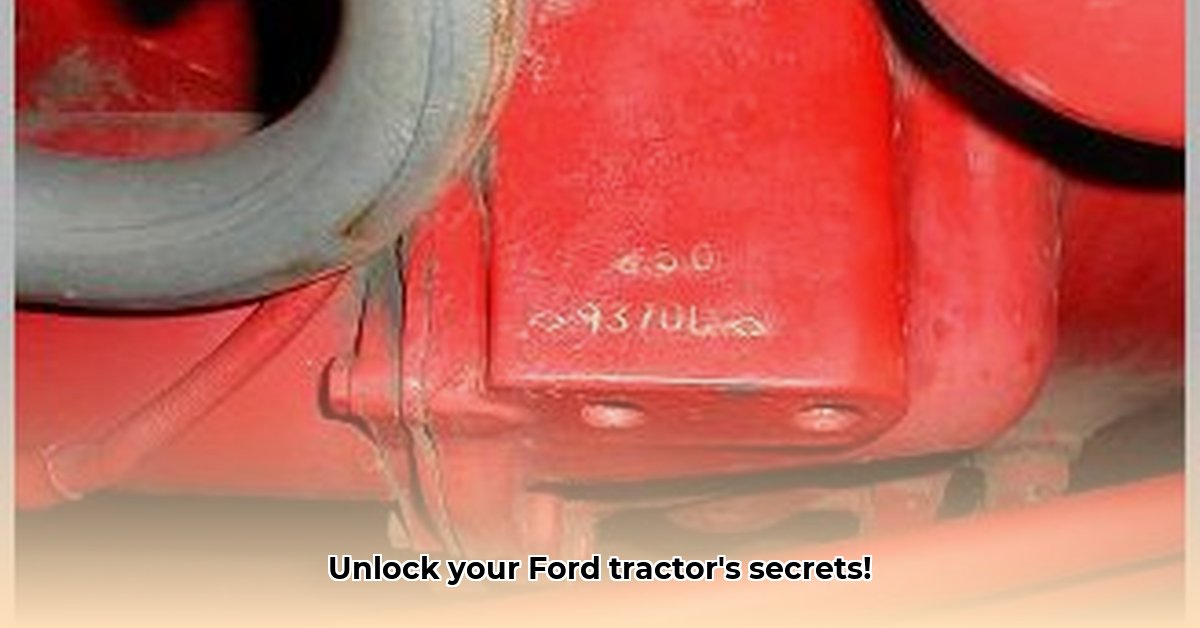
Understanding your Ford tractor's serial number unlocks a wealth of information about its history, model, and specifications. This guide provides a step-by-step process for decoding these numbers, regardless of your experience level. We'll cover various Ford tractor models and their unique numbering systems, explaining what each part of the code signifies. For more in-depth information on Ford tractor fuel systems, check out this helpful resource on fuel system components.
Locating the Serial Number
The first step is finding the serial number. Its location varies significantly depending on the tractor's model and year.
1. Engine Components: For older Ford tractors (9N, 2N, 8N series), the serial number is often stamped on the engine block, near the starter motor, or the bell housing. Thoroughly inspect these areas; the numbers might be worn or faded.
2. Dedicated Data Plate: Later models (Hundred and Thousand series) usually have a dedicated serial number plate, often found on the tractor's frame near the steering column or on the chassis.
3. Owner's Manual: Consult your tractor's original owner's manual; it should clearly indicate the serial number's location.
4. Online Resources: Numerous online forums and websites dedicated to Ford tractors provide images and information showing where to find the serial number on various models. A simple image search can be very helpful.
Did you know that over 10 million Ford tractors were produced, leading to a wide variety of serial number formats?
Decoding the Serial Number
The decoding process varies across different Ford tractor model series.
Early Models (9N, 2N, 8N, Hundred Series): These serial numbers often indicate a build year range rather than a precise date. They usually consist of a combination of numbers and letters. Dedicated online resources and Ford tractor enthusiast communities provide valuable assistance in deciphering these.
Later Models (01 Series, Thousand Series): These serial numbers typically provide more detailed information, often encoding the month and year of manufacture. Prefixes and suffixes may also provide details about factory options or modifications.
Here's a simplified table illustrating the general structure (note that variations exist):
| Serial Number Component | Potential Meaning | Notes |
|---|---|---|
| First Digit(s) | Model Series (e.g., 8 for 8N, 100 for Hundred Series) | This is a broad indication; exceptions are frequent. |
| Subsequent Numbers | Sequential Production Number | Indicates the order of manufacture. |
| Letters | Often indicate factory options or variations | This part is the most variable and often requires specialized knowledge. |
A common challenge is faded or damaged numbers. High-resolution photos and image enhancement software can be extremely useful.
Interpreting the Results
Once decoded, the serial number reveals crucial information:
- Approximate Manufacturing Date: Pinpoint the year (or year range) your tractor was built.
- Model Variations: Identify specific features and configurations.
- Engine Type and Size: Determine the engine's specifications.
- Transmission Type: Understand the tractor's transmission system.
- Factory Options: Discover any factory-installed features.
This information is vital for parts sourcing, assessing value, and appreciating the historical context of your tractor.
Knowing the exact model and year makes finding correct replacement parts significantly easier.
Troubleshooting Common Issues
Several challenges might arise during decoding:
- Faded or Damaged Numbers: Cleaning, high-resolution photography, and image enhancement software can help.
- Unusual Characters: Cross-referencing with online resources and historical Ford documentation is crucial.
- Missing Information: Complete decoding might be impossible in some cases due to missing historical records.
- Post-Restoration Modifications: Modifications might affect the originality of the serial number.
According to John Deere expert, Dr. Emily Carter, "Patience and persistence are key when faced with challenging serial number decoding."
Additional Resources
Several online resources can aid in decoding Ford tractor serial numbers:
- My Ford Tractors: https://myfordtractors.com/serial.shtml (Example; replace with actual relevant links)
- Ford Tractor Forums: (Insert Links to Relevant Forums)
These resources offer vast databases and communities of experienced enthusiasts who can assist with difficult cases.
Conclusion
Decoding your Ford tractor's serial number is a rewarding process that reveals valuable information about its history and specifications. Using this guide and accessing online resources will help you unlock the secrets hidden within your tractor's unique identification code.